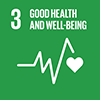Related SDGs

Goal 3
Related news
Sustainable Development Goal 3 of the 2030 Agenda for Sustainable Development is to
“ensure healthy lives and promoting well-being for all at all ages”. TThe associated targets aim to reduce the global maternal mortality ratio; end preventable deaths of newborns and children; end the epidemics of AIDS, tuberculosis, malaria and other communicable diseases; reduce mortality from non-communicable diseases; strengthen the prevention and treatment of substance abuse; halve the number of deaths and injuries from road traffic accidents; ensure universal access to sexual and reproductive health-care services; achieve universal health coverage; and reduce the number of deaths and illnesses from hazardous chemicals and pollution.
The MDG era and before
As part of the efforts to achieve the maternal and child health MDGs, the UN Secretary-General Ban Ki-moon launched the Every Woman Every Child initiative at the United Nations Millennium Development Goals Summit in September 2010. Every Woman Every Child is an unprecedented global movement that mobilizes and intensifies international and national action by governments, multilaterals, the private sector and civil society to address the major health challenges facing women and children around the world. The movement puts into action the Global Strategy for Women and Children’s Health, which presents a roadmap on how to enhance financing, strengthen policy and improve service on the ground for the most vulnerable women and children.
The Commission on Sustainable Development considered Health and sustainable development as a cross-cutting issue during the two-year cycle of its multi-year programme of work.
Health and Sustainable Development was also an integral part of the World Summit on Sustainable Development, held in Johannesburg in 2002. The outcome document of the Summit, the Johannesburg Plan of Implementation, devotes Chapter 6 to Health and Sustainable Development, recalling that human beings are entitled to a healthy and productive life, in harmony with nature and further recognizes that the goals of sustainable development can only be achieved in the absence of a high prevalence of debilitating diseases, while obtaining health gains for the whole population requires poverty eradication.
The outcome of the United Nations on Environment and Development, Agenda 21, devotes Chapter 6 to “Protecting and Promoting Human Health”. The Agenda recognizes that health and development are intimately interconnected, and call that action items under Agenda 21 must address the primary health needs of the world's population, since they are integral to the achievement of the goals of sustainable development and primary environmental care